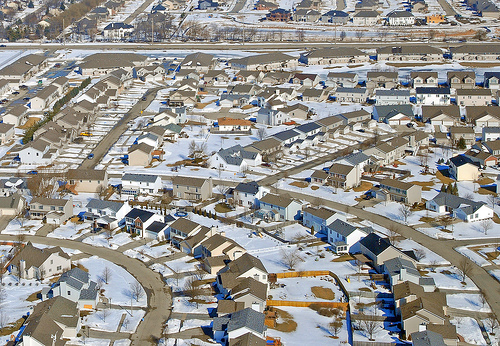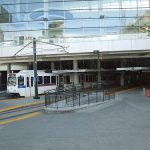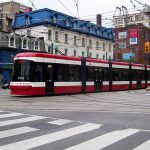How policy leads to sprawl
Development policy leads to urban sprawl, and the resulting costs are enormous. A new report, Analysis of Public Policies That Unintentionally Encourage and Subsidize Urban Sprawl, authored by Todd Litman of the Victorian Transport Policy Institute, investigates. Sprawl results in drops in ecological and agricultural productivity, higher public infrastructure and service costs, and greater transportation costs, which includes traffic, accidents, pollution, lowered public health and fitness, and more. Sprawl’s impact is impressively expensive: “$400 billion dollars in external costs and $625 billion in internal costs annually in the U.S.,” found the study.

Image from tlindenbaum.
Exploring both sprawl and its alternative, “smart growth,” the report outlines the benefits and costs associated with sprawl, and the policies that encourage it, pinpointing potential policy changes that might lead to better development patterns. The analysis identifies “basic physical impacts of sprawl, including increases in the amount of land developed per capita, and dispersion of destinations which increases per capita motor vehicle travel” in order to better understand the impact of policy on sprawl, and the impact of sprawl on communities.
But first, some background: The globe is quickly urbanizing, creating huge effects economically, socially and environmentally. This report focuses on the costs of sprawl as well as the benefits of sprawl’s opposite, smart growth. Sprawl leads to two major physical effects: 1) the amount of land developed and 2) how far apart destinations are, which in turn leads to increased car travel. The result? “Compared with smart growth development, sprawl typically increases per capita land consumption 60-80% and motor vehicle travel by 20-60%.”
Other of the study’s findings were just as startling. For one, sprawl’s impact on reducing affordable transportation — walking, cycling and public transit — is regressive, which means that the burden is largely put upon people with physical, economic and social disadvantages. Sprawl can impact urban poverty, where it tends to make social ills, like dysfunctional families and crime, worse. Sprawl also reduces economic productivity, by increasing infrastructure costs and increasing spending on imported goods like fuel and cars.
Yet sprawl also provides benefits, points out Litman. Unfortunately, these are “mostly direct internal benefits to sprawled community residents; there is little reason to expect sprawl to provide significant external benefits to non-residents since rational consumers and businesses internalize benefits and externalize costs.” So, if sprawl is socially and economically damaging, what’s an urban planner to do? The study, concurring with previous research, suggests that cities should “expand systematically” along major transit and utility corridors, for one.
Further, Litman categorizes cities into three types, each with recommendations (and their own limitations):
- “Unconstrained” cities surrounded by abundant land; these can expand “significantly” and should “maintain strong downtowns surrounded by higher-density neighborhoods with diverse, affordable housing options”;
- “Semi-constrained” cities with limited ability to expand should “include a combination of infill development and modest expansion on major corridors,” and should “maintain strong downtowns surrounded by higher density neighborhoods” while discouraging private car ownership through pedestrian-friendly design, road pricing and other tactics; and
- “Constrained” cities, which can’t expand much but which require increased density for population and economic growth, should be guided by “strong policies that maximize livability,” such as through “well-designed streets,” green space, efficient transportation policies, and restrictions on vehicle ownership, among other methods.
While the report is comprehensive, more work remains to be done. “Urban planning decisions involve numerous trade-offs between various planning objectives, so many different factors must be considered when evaluating policies and projects,” notes the study. “More research is needed to better understand the full benefits and costs of specific policy and planning decisions and determine the best policies to implement in a particular situation.”
Related Posts
Category: Transportation

















